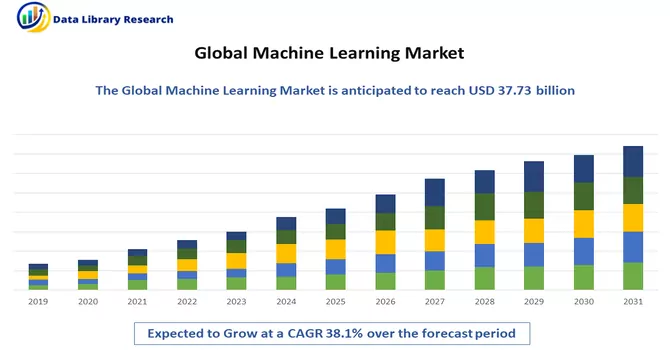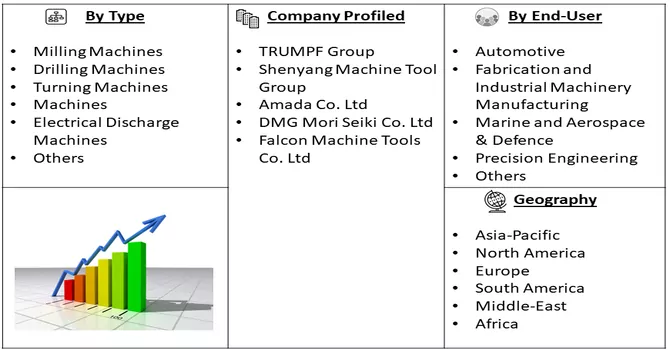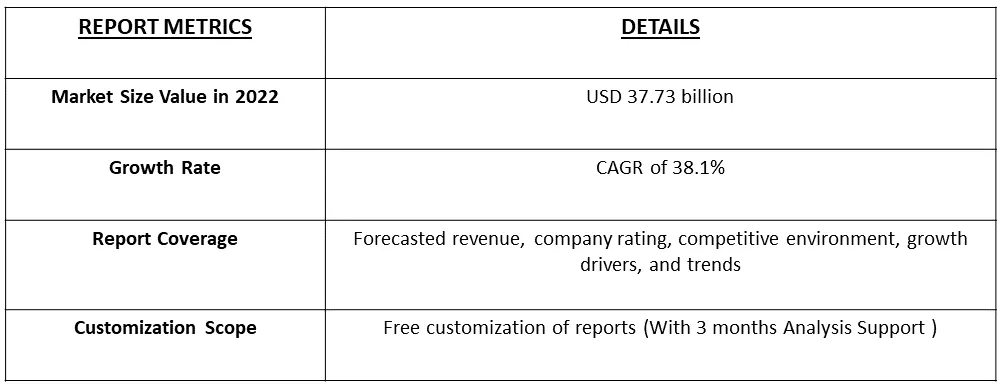The global machine learning market size was valued at USD 37.73 billion in 2022 and is expected to grow at a compound annual growth rate (CAGR) of 38.1% from 2023 to 2030.

Get Complete Analysis Of The Report - Download Free Sample PDF
Machine tool manufacturers are companies that specialize in the design, production, and distribution of machinery crucial to the manufacturing industry. These machines are instrumental in shaping and machining various materials, such as metal, plastic, wood, or composites, through processes like cutting, grinding, drilling, milling, turning, and deformation. They play a vital role in enabling the precise and intricate production of components for diverse industries. These manufacturers may focus on specific types of machines or offer a range of products to meet diverse manufacturing needs. Staying competitive in the industry requires keeping pace with technological advancements, including the integration of IoT, artificial intelligence, and automation into machine tools. The continuous development of more sophisticated and efficient machines is essential for meeting the evolving demands of the global manufacturing landscape.
The demand for machine tools is intricately linked to global manufacturing trends. As industries expand and evolve, there is an increasing need for specialized and high-performance machine tools. Manufacturers must be agile in adapting to these changing market demands to remain successful. In recent years, technology has brought about significant changes in the machine tool industry. The integration of digital services, products, and supply chain optimization has revolutionized the consumer experience. Startups are focusing on specialized solutions, while established technology firms are heavily investing in AI platforms, with Machine Learning (ML) gaining significant momentum due to its rapid progress in the industry. This progress is transforming the landscape, requiring manufacturers to embrace these technological advancements to stay at the forefront of innovation.
The pervasive trend of embracing Industry 4.0 principles remains prominent, with machine tool manufacturers progressively integrating smart technologies, IoT sensors, and data analytics to elevate connectivity, automation, and overall efficiency within manufacturing processes. Ongoing advancements in computer numerical control (CNC) technology further contribute to enhancements in precision, speed, and flexibility. Machine tools are evolving into more intelligent systems, enabling improved control, monitoring, and programming capabilities.
Market Segmentation: The Machine Tools Manufacturers and the Market is Segmented by Type (Milling Machines, Drilling Machines, Turning Machines, Grinding Machines, Electrical Discharge Machines among others), End User (Automotive, Fabrication, and Industrial Machinery Manufacturing, Marine and Aerospace & Defence , Precision Engineering, and Other End Users), and Geography (Asia-Pacific, North America, Europe, Latin America, and Middle East & Africa). The market size and forecasts are Provided in terms of values (USD billion) for all the above segments.

For Detailed Market Segmentation - Download Free Sample PDF
Market Drivers:
Milling Machines Play A Crucial Role In The Machine Tool Manufacturing Market
Machine learning stands out as a versatile tool employed across a spectrum of machining operations, encompassing cutting, shaping, drilling, and finishing. Its indispensability lies in its role in the production of precision components spanning diverse industries. Here are essential facets concerning milling machines within the machine tool manufacturing market: Milling machines are available in various types, each tailored for specific applications. Among the common types are vertical milling machines, horizontal milling machines, and CNC milling machines. The significance of CNC (Computer Numerical Control) milling machines is particularly pronounced in modern manufacturing, owing to their precision and automation capabilities. Renowned for their capacity to achieve exceptionally high levels of precision in the machining of intricate parts, milling machines play a crucial role in producing components with stringent tolerances. This is particularly evident in industries such as aerospace, automotive, and medical.
Furthermore, the recent developments are driving the growth of the studied market. For instance, in May 2023, Infineon Technologies AG completed the acquisition of Imagimob AB, a leading platform supplier based in Stockholm, specializing in edge-device Machine Learning solutions. This strategic move solidified Infineon Technologies AG's standing as a premier provider of Machine Learning (ML) solutions, significantly augmenting its portfolio of AI products. Imagimob AB is recognized for its comprehensive machine-learning toolchain, known for its exceptional adaptability and user-friendly interface. The company places a significant emphasis on producing ML models suitable for production, further enhancing Infineon's capabilities in the realm of advanced machine learning solutions. Thus, such developments are diving the growth of the studied market.
The Marine and Aerospace Defense Sectors Are Significant Consumers Of Precision Tools And Equipment,
Precision tools and equipment, particularly those manufactured by machine tool producers, play a vital role in catering to the substantial needs of the Marine and Aerospace Defense sectors. The production of components for marine vessels and aerospace defense systems necessitates the highest levels of precision, reliability, and adherence to stringent quality standards. Here are essential considerations regarding the utilization of machine tools in the manufacturing market for marine and aerospace defense. In the aerospace defense industry, machine tools are indispensable for the precision machining of various aircraft components. This encompasses the manufacturing of critical parts like turbine blades, engine components, and structural elements. Given the intricate designs and strict tolerances associated with aerospace components, CNC (Computer Numerical Control) machining, facilitated by advanced milling and turning machines, becomes instrumental in ensuring the precision required for these complex geometries.
Restraints
Data Breaching Issues
Another concern arises from the potential for data poisoning, where attackers inject malicious data during the training phase of a machine learning model. This can result in the model making biased or inaccurate predictions, potentially leading to unauthorized access or disclosure of sensitive information during real-world use. Moreover, the increasing use of machine learning in cybersecurity itself has prompted a cat-and-mouse game between attackers and defenders. As attackers adapt their techniques, defenders must continually update and reinforce their machine learning-based security measures to thwart evolving threats. Thus, these factors may slow down the growth of the studied market.
The COVID-19 pandemic has had a profound impact on the machine learning market, influencing both its short-term dynamics and long-term trends. The pandemic acted as a catalyst for digital transformation across industries. Businesses, governments, and organizations rapidly adopted machine learning and artificial intelligence solutions to navigate the challenges posed by the crisis. Machine learning played a crucial role in automating processes, enhancing data analysis, and enabling more efficient decision-making in the face of unprecedented disruptions. The pandemic altered consumer behavior, creating a need for businesses to recalibrate their strategies. Machine learning played a role in analyzing changing consumer patterns, enabling businesses to tailor their offerings and marketing strategies to align with the new normal. Thus, the market is expected to witness significant growth over the forecast period.
Segmental Analysis:
Milling Machine Segment is Expected to Witness Significant growth over the Forecast Period
Milling machines, a staple in manufacturing, have witnessed a transformative integration with machine learning technologies, ushering in a new era of precision, efficiency, and adaptability. Machine learning facilitates the integration of milling machines with collaborative robots. These robots can adapt their movements based on the real-time feedback received from the milling machine, allowing for more flexible and efficient automation in manufacturing processes. Thus, the integration of machine learning with milling machines brings about a paradigm shift in manufacturing. From optimizing tool performance and predicting maintenance needs to enhancing energy efficiency and enabling smart automation, the collaboration between milling machines and machine learning paves the way for more intelligent and adaptive machining processes.
Automotive Segment is Expected to Witness Significant growth over the Forecast Period
The automotive industry has been at the forefront of adopting machine learning, leveraging its capabilities to enhance various aspects of vehicle design, manufacturing, safety, and user experience. Machine learning plays a pivotal role in enabling autonomous vehicles to perceive and interpret their surroundings. Advanced driver-assistance systems (ADAS) utilize machine learning algorithms to process data from sensors such as cameras, LiDAR, and radar, allowing vehicles to make real-time decisions based on the surrounding environment. Thus, the automotive segment's integration with machine learning extends across various domains, from enhancing vehicle safety and manufacturing processes to providing personalized driving experiences and optimizing supply chain operations. As technology continues to evolve, machine learning is poised to play an increasingly crucial role in shaping the future of the automotive industry, as a result the segment is expected to witness significant growth over the forecast period.
North America Region is Expected to Witness Significant growth over the Forecast Period
North America emerged as a powerhouse in the machine learning market, claiming a dominant position. This ascent is propelled by the far-reaching impact of machine learning on societal functions, sparking a heightened emphasis on ethical AI and responsible practices across the region. Companies are placing a premium on values like fairness, transparency, and accountability in the development of machine learning models, actively addressing biases, ensuring privacy standards, and navigating the ethical complexities associated with AI applications. To steer the ethical course of machine learning, regulatory frameworks, guidelines, and industry standards are taking shape, actively developed to ensure that the deployment of these technologies aligns with ethical standards and societal expectations. The goal is to foster an environment where machine learning serves as a force for good. In the healthcare domain, machine learning is catalyzing transformative changes, particularly in medical diagnostics. A standout example is the algorithm developed by Google's DeepMind division, proficient in recognizing retinal images indicative of conditions like diabetic retinopathy. This breakthrough not only enables early detection but also facilitates prompt treatment, alleviating the burden on medical staff.
Beyond diagnostics, machine learning is a linchpin in various healthcare facets, including personalized medicine, disease outbreak prediction, and drug development. Its ability to analyze vast datasets contributes to more precise medical interventions and tailored treatment approaches, heralding a new era in healthcare innovation. A pivotal moment in July 2023 saw the launch of a comprehensive 360-degree program in machine learning and data science by the well-regarded online learning platform "Geekster." This strategic initiative responds to the escalating demand for skilled professionals in the domain. The program offers an immersive learning experience, featuring over 500+ Live Learning Hours led by industry experts, 25 real-world projects, and personalized mentoring for learners. The confluence of ethical considerations, regulatory frameworks, and transformative applications, especially in healthcare and education, underscores North America's ongoing leadership in not only embracing but also shaping the responsible use of machine learning technologies. As the region pioneers these advancements, it sets the tone for a future where technology aligns harmoniously with human values and societal well-being.

Get Complete Analysis Of The Report - Download Free Sample PDF
The machine tools market displays a considerable level of fragmentation, characterized by the presence of major global players alongside numerous local small and medium-sized entities. A noticeable trend in the industry involves a shift towards heightened automation, with companies actively engaged in developing more automated solutions. Automation is emerging as a favored strategy, underscoring the industry's dedication to augmenting operational efficiency. Furthermore, a discernible pattern in the sector revolves around consolidation through mergers and acquisitions. Companies are strategically employing these measures to bolster their market presence, enter new geographic regions, and attract a broader clientele. This strategic approach aligns with the industry's overarching goals of achieving growth and diversification. Key participants in the industry encompass notable names such as:
Recent Development:
1) In March 2023, Phillips Machine Tools revealed a strategic alliance with JFY International, an entity within the TRUMPF Group. This collaboration aims to diversify Phillips Machine Tools' solution portfolio for clients engaged in metal processing. JFY International operates as a comprehensive provider of sheet metal processing solutions, encompassing CNC bending, punching, shearing, 2D laser cutting machines, and automation services, ranging from individual machines to fully automated production lines. With a commitment to professional consulting, swift responses, and exceptional on-time services, JFY International ensures a high standard of support through its network of partners.
2) In December 2022, EIT Manufacturing, the leading innovation community in the European industrial sector, partnered with AMT – Advanced Machine Tools. AMT, a biennial event showcasing the latest advancements in machine tools, machinery deformation, cutting and forming technologies, instruments, components, accessories, and related industries, collaborates with EIT Manufacturing to drive innovation and digital transformation in the metal industry. Through this collaborative agreement, industrial manufacturing specialists in Europe gain access to a wealth of opportunities facilitated by EIT Manufacturing and AMT's joint efforts.
Q1. What was the Machine Learning Market size in 2022?
The global machine learning market size was valued at USD 37.73 billion in 2022.
Q2. At what CAGR is the Machine Learning Market projected to grow within the forecast period?
Machine Learning Market is expected to grow at a compound annual growth rate (CAGR) of 38.1% over the forecast period.
Q3. What are the factors on which the Machine Learning Market research is based on?
By Type, End User and Geography are the factors on which the Machine Learning Market research is based.
Q4. Which Region is expected to hold the highest Market share?
North America region is expected to hold the highest Market share.
Data Library Research are conducted by industry experts who offer insight on industry structure, market segmentations technology assessment and competitive landscape (CL), and penetration, as well as on emerging trends. Their analysis is based on primary interviews (~ 80%) and secondary research (~ 20%) as well as years of professional expertise in their respective industries. Adding to this, by analysing historical trends and current market positions, our analysts predict where the market will be headed for the next five years. Furthermore, the varying trends of segment & categories geographically presented are also studied and the estimated based on the primary & secondary research.
In this particular report from the supply side Data Library Research has conducted primary surveys (interviews) with the key level executives (VP, CEO’s, Marketing Director, Business Development Manager and SOFT) of the companies that active & prominent as well as the midsized organization
FIGURE 1: DLR RESEARH PROCESS

Extensive primary research was conducted to gain a deeper insight of the market and industry performance. The analysis is based on both primary and secondary research as well as years of professional expertise in the respective industries.
In addition to analysing current and historical trends, our analysts predict where the market is headed over the next five years.
It varies by segment for these categories geographically presented in the list of market tables. Speaking about this particular report we have conducted primary surveys (interviews) with the key level executives (VP, CEO’s, Marketing Director, Business Development Manager and many more) of the major players active in the market.
Secondary ResearchSecondary research was mainly used to collect and identify information useful for the extensive, technical, market-oriented, and Friend’s study of the Global Extra Neutral Alcohol. It was also used to obtain key information about major players, market classification and segmentation according to the industry trends, geographical markets, and developments related to the market and technology perspectives. For this study, analysts have gathered information from various credible sources, such as annual reports, sec filings, journals, white papers, SOFT presentations, and company web sites.
Market Size EstimationBoth, top-down and bottom-up approaches were used to estimate and validate the size of the Global market and to estimate the size of various other dependent submarkets in the overall Extra Neutral Alcohol. The key players in the market were identified through secondary research and their market contributions in the respective geographies were determined through primary and secondary research.
Forecast Model
